A nurse is assessing a client who is being admitted from the Post-Anesthesia Care Unit (PACU) following an abdominal hysterectomy. Which of the following assessments is the nurse's priority?
Urinary output
Oxygen saturation
Abdominal dressing
Pain level
The Correct Answer is B
Choice A reason:
While monitoring urinary output is important after surgery to ensure kidney function and that the urinary tract has not been compromised during surgery, it is not the immediate priority. The nurse should ensure that the client is not experiencing postoperative complications such as urinary retention, but this comes after the assessment of vital signs.
Choice B reason:
Oxygen saturation is the priority assessment for a client being admitted from the PACU following an abdominal hysterectomy. Maintaining adequate oxygenation is critical after anesthesia, as respiratory function can be compromised. The nurse must ensure the client's airway is clear and that they are receiving sufficient oxygen to prevent hypoxia and other respiratory complications.
Choice C reason:
Inspecting the abdominal dressing is necessary to check for signs of bleeding or infection at the surgical site. However, this is not the first priority upon admission from the PACU. The nurse will assess the dressing after vital signs and oxygen saturation have been addressed.
Choice D reason:
Pain management is a significant part of postoperative care, and the nurse will need to assess the client's pain level to manage it effectively. However, the immediate priority is to ensure the client's vital signs are stable, which includes oxygen saturation, before addressing pain.
Nursing Test Bank
Naxlex Comprehensive Predictor Exams
Related Questions
Correct Answer is D
Explanation
Choice A reason:
Hyperplasia is an increase in the number of cells in an organ or tissue, which can lead to its enlargement. While hyperplasia can be a response to a stimulus and is not necessarily precancerous, it does not describe the abnormal changes in the shape, size, and organization of mature cells.
Choice B reason:
Metaplasia is a reversible change in which one differentiated cell type is replaced by another cell type. This process can be a response to chronic irritation and inflammation, and while it may predispose cells to cancerous changes, it is not in itself a precancerous condition.
Choice C reason:
The term 'malignant' refers to cancerous cells that have the ability to invade and destroy nearby tissue and spread to other parts of the body. The description of the cells as 'moderately abnormal' does not indicate that the cells are malignant but rather that they are showing signs of potentially precancerous changes.
Choice D reason:
Dysplasia refers to the presence of abnormal cells within a tissue or organ. It is characterized by changes in cell size, shape, uniformity, arrangement, and structure, particularly when such changes are strongly suggestive of developing neoplasia, or new, abnormal growth. In the context of a Pap smear, dysplasia is indicative of precancerous changes and is the term used to describe the abnormal development of cells on the cervix.
Correct Answer is C
Explanation
Choice A reason:
Skin traction is indeed less restrictive than skeletal traction, allowing for more mobility. It is applied using bandages or adhesive material to the skin, which can be removed or adjusted more easily than the pins or screws used in skeletal traction. This type of traction is typically used for short-term treatment before surgery or when the injury is less severe.
Choice B reason:
Discomfort levels can vary depending on the individual and the specific circumstances of the traction. However, skin traction is generally considered to be less painful than skeletal traction because it is less invasive and applies less force. Skeletal traction, which involves the insertion of pins or wires directly into the bone, is likely to cause more discomfort due to the invasive nature of the procedure.
Choice C reason:
Skeletal traction is more appropriate for reducing fractures, especially in cases where a greater force is needed to align the bones. It involves the surgical insertion of pins or wires directly into the bone, allowing for a stronger and more stable pull that is necessary for the realignment of complex fractures.
Choice D reason:
Skeletal traction carries a higher risk of infection compared to skin traction because it is more invasive. The insertion of pins or wires into the bone creates a potential entry point for bacteria, which can lead to infection at the site of insertion.

Whether you are a student looking to ace your exams or a practicing nurse seeking to enhance your expertise , our nursing education contents will empower you with the confidence and competence to make a difference in the lives of patients and become a respected leader in the healthcare field.
Visit Naxlex, invest in your future and unlock endless possibilities with our unparalleled nursing education contents today
Report Wrong Answer on the Current Question
Do you disagree with the answer? If yes, what is your expected answer? Explain.
Kindly be descriptive with the issue you are facing.
